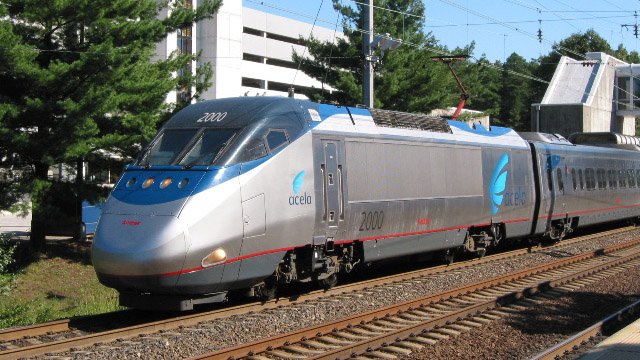By: Michael Alexander
First there was Fred Flintstone's foot-powered car. At some point in the future, we may find something similar to George Jetson's flying saucer. Whether pedaling with our toes or zooming through the stratosphere, transportation has morphed from a mere necessity into a standard life luxury. Throughout history, humans have engineered increasingly clever, exhilarating, and mindful methods of getting around. These days, we head into an era of conscious effort to positively change the climate. The argument over electric vehicles vs gasoline fuel dominates the conversation about emissions and human footprint. However, I would venture to argue that considering high-speed rail could be one of the best economical, climate-conscious cultural shifts that we could make.
Movies have fueled our imagination with cars, ships, and other transportation feats promising a world where distance was no obstacle. Feeding into our appetite for size and style, cars have been a predominant source for pollution and human desire. Physics and economics have since grounded us in reality, yet the dream of futuristic, efficient travel persists. What is "good" transportation? Luxury? Safety? Economy? High-speed rail might offer an answer to all these questions.
Coming from someone who has been on a high-speed train, I'd say it's something that is missing in America, especially in such a transit hub as Chicago. My experience riding the Shanghai Maglev (China) provided a glimpse into a future with more opportunity to travel without harsh security and with more safety. The journey was remarkably smooth, efficient, and covered a significant distance in a fraction of the time a car would take. It was an eye-opening experience that left me wondering: Why hasn't the United States, particularly the Midwest, embraced this type of technology?
Enter high-speed rail – a tangible and viable option towards the future of climate-friendly transportation, competing with the compelling comfort and routine of planes and cars. On average, trains are significantly more energy efficient per passenger than air travel. For short to medium distances, the contrast is even more pronounced. Taking a train instead of a domestic flight would reduce your emissions by around 86%. This means trains emit only about 14% of the carbon that planes do for similar journeys.
Tokaido Shinkansen High-Speed line in Japan
The efficiency gap narrows for very long distances. It's when journeys start getting longer than about 700 miles that planes start to gain an advantage on trains. However, for most domestic travel, trains remain the more eco-friendly option.
As we look to the future, the vision of high-speed rail in the Midwest represents more than just efficient transportation. It embodies a shift towards sustainable, economically viable transit solutions that could transform the region's landscape and economy. While we may not have the flying cars of "The Jetsons," the reality of high-speed rail offers a glimpse into a future that balances technological advancement with practical implementation. As the world grows, we need more ways of moving in mass and economy.
The Acela Express, Inner City, High Performance East Coast Train, USA
The Environmental Law and Policy Center (ELPC) has been at the forefront of advocating for high-speed rail development in the Midwest for decades. Their efforts date back to the 1990s when they successfully lobbied against the construction of the I-69 highway in Indiana, demonstrating a commitment to rail as an alternative to highway expansion. Despite decades of planning and advocacy, high-speed rail in the Midwest has yet to materialize on a large scale. The region's potential for a hub-and-spoke network centered on Chicago has been recognized since the 1990s, but progress has been slow.
To gain insight from a real authority on the matter, I reached out to a contact at the ELPC. Kevin Brubaker, who has been with the ELPC for nearly three decades working on high-speed rail projects, identifies significant hurdles: "Rail congestion. Chicago is the hub for both passenger and freight rail
service in the Midwest and the nation. We're trying to build 21st-century infrastructure on 19th-century rights of way. It gets very complicated when you need to cross over tracks owned by different railroads." One of the other main challenges, according to Brubaker, is the competition for government funding. He also mentions that the public gets behind it, when they have information on it. Other forms of information and information for other transportation styles may be more effective.
The complex infrastructure challenge, combined with funding issues, political obstacles, and competition from other transportation modes, has delayed the implementation of high-speed rail in the Midwest. While recent federal initiatives have injected new momentum into rail projects, a fully realized high-speed network in the region may still be years away, pending resolution of these longstanding challenges.
Have you ever experienced a high speed train ride? Exploring videos on Youtube showcasing trains from around the world can provide a glimpse into the potential of rail travel. These experiences highlight the promise of more fast, efficient transportation. Trains represent one of the most promising and accessible solutions for sustainable travel, combining comfort with reduced environmental impact. As we look towards a greener future, embracing rail technology could revolutionize how we move between cities and regions. May Chicago lead the way, as the city always has.
Sources:
Environmental Law and Policy Center. (n.d.). It's time for a rail revolution. Retrieved January 2, 2025, from https://elpc.org/blog/its-time-for-a-rail-revolution/ Environmental Law and Policy Center. (n.d.). Midwest rail. Retrieved January 2, 2025, from https://elpc.org/projects/midwest-rail/
Ritchie, H. (2023). Which form of transport has the smallest carbon footprint? Our World in Data. https://ourworldindata.org/travel-carbon-footprint
International Energy Agency. (2020). Long-distance transport – Energy Efficiency 2020. https://www.iea.org/reports/energy-efficiency-2020/long-distance-transport New York Times. (2024, April 4). Trains, planes, carbon footprint pollution. https://www.nytimes.com/2024/04/04/climate/trains-planes-carbon-footprint-pollution. html
Environmental Law and Policy Center. (n.d.). In Wikipedia. Retrieved January 2, 2025, from https://en.wikipedia.org/wiki/Environmental_Law_and_Policy_Center Environmental Law and Policy Center. (n.d.). New regional rail vision is a win for the Midwest. Retrieved January 2, 2025, from
https://elpc.org/blog/new-regional-rail-vision-is-a-win-for-the-midwest/ Environmental Law and Policy Center. (n.d.). Accelerating the Midwest higher-speed rail network. Retrieved January 2, 2025, from
https://elpc.org/blog/accelerating-the-midwest-higher-speed-rail-network/ Environmental Law and Policy Center. (n.d.). Midwest electric school bus update. Retrieved January 2, 2025, from
https://elpc.org/blog/midwest-electric-school-bus-update/
High Speed Rail Alliance. (n.d.). Celebrating 30 years of advocacy. Retrieved January 2, 2025, from https://www.hsrail.org/blog/celebrating-30-years-of-advocacy/ Environmental Law and Policy Center. (n.d.). Get ready Midwest: Rail projects are ready to roll. Retrieved January 2, 2025, from
https://elpc.org/blog/get-ready-midwest-rail-projects-are-ready-to-roll/ Public Interest Law Initiative. (n.d.). Environmental Law and Policy Center of the Midwest. Retrieved January 2, 2025, from
https://pili.org/agencies/environmental-law-and-policy-center-of-the-midwest/ RE-AMP Network. (n.d.). ELPC identifies 460 businesses in industrial Midwest in high-speed rail supply chain. Retrieved January 2, 2025, from
https://www.reamp.org/elpc-identifies-460-businesses-in-industrial-midwest-in-high-spe ed-rail-supply-chain/
Acela Express train. (2000). [Photograph]. Wikipedia.
https://en.wikipedia.org/wiki/High-speed_rail#/media/File:Acela_2000.jpgBrubaker, K. (2025, January 2). Personal interview [Personal interview].



